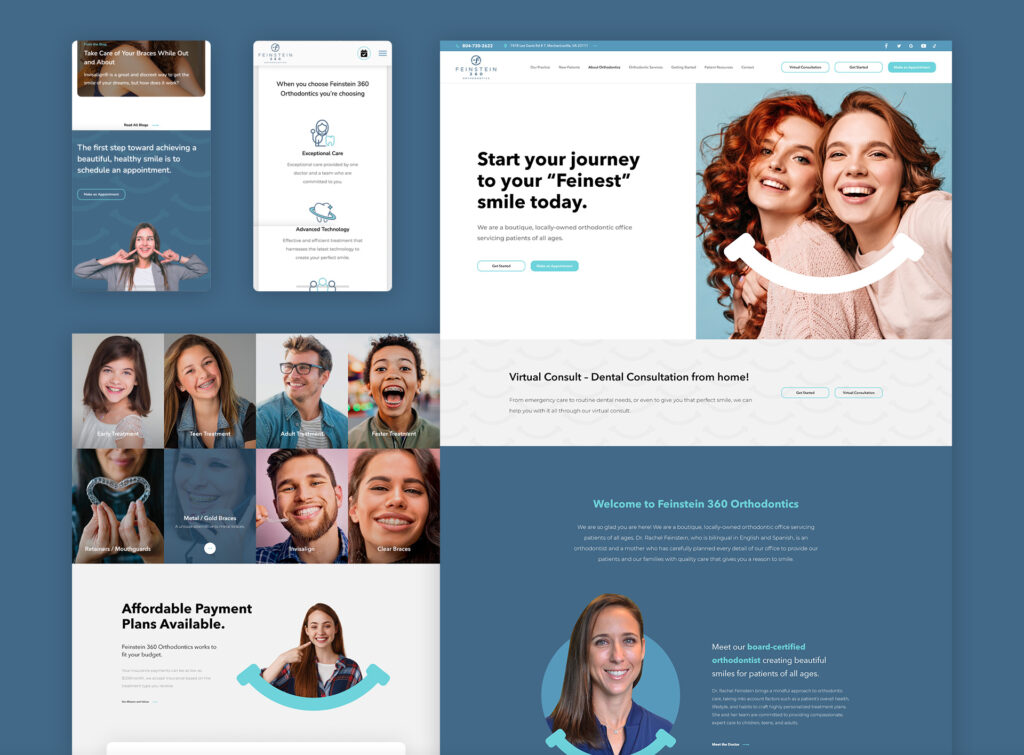Top Web Design Trends for 2025: Elevate Your Orthodontic or Pediatric Dental Website

The digital landscape evolves fast—and 2025 is no exception. For orthodontic and pediatric dental practices, keeping your website current with modern design trends isn’t just about aesthetics. It’s about building trust, providing a seamless experience, and converting online visitors into long-term patients.
In today’s digital-first world, your website is often your first impression. So, how do you ensure it reflects the quality of care you provide? Below, we explore the top web design trends for 2025—and how you can apply them to elevate your orthodontic or pediatric dental website without compromising functionality.
1. Clean Design Meets Bold Typography
The Trend: Minimalist design continues to lead, but 2025 introduces even bolder typography—large, statement-making text paired with simple, clean layouts.
Why It Matters: A clutter-free interface enhances clarity and trust, while bold typography grabs attention and communicates confidence. Pediatric dental sites can use vibrant yet minimal design for a playful, approachable feel. Orthodontic practices can lean into bold type and sleek layouts for a polished, modern look.
How to Apply It:
- Strong CTAs: Use clear, bold phrases like “Schedule Now” or “Start Your Smile Journey.”
- Whitespace: Let your design breathe—strategic spacing improves readability and directs focus.
- On-Brand Colors: Use a minimalist palette with soft tones (ideal for pediatrics) or bold contrasts (great for ortho) to match your brand identity.
2. Interactive Features That Add Value
The Trend: Engagement is key. In 2025, smart interactivity—like quizzes, scheduling tools, and chat—goes beyond gimmicks and becomes central to the user experience.
Why It Matters: Interactive elements help patients feel informed and supported. They create a connection before the first visit and ease common anxieties.
How to Apply It:
- Virtual Consultations: Offer a quick and easy way to meet online before coming in.
- Self-Assessment Quizzes: Help users determine if their child needs braces or when to schedule a first dental visit.
- Live Chat: Offer real-time answers to common questions—no need to call or wait for an email reply.
3. Microinteractions That Guide and Delight
The Trend: Microinteractions—small animations, hover effects, and visual cues—create smoother, more intuitive navigation.
Why It Matters: Subtle movements provide reassurance and clarity without overwhelming the user. This is especially helpful on sites catering to busy parents or first-time orthodontic patients.
How to Apply It:
- Hover Effects on service links and buttons to signal interactivity.
- Confirmation Animations when a user books an appointment or submits a form.
- Scrolling Animations that introduce key info without slowing the user down.
4. Voice Search Optimization
The Trend: Voice search is growing fast. In 2025, it’s not optional—it’s essential.
Why It Matters: Many users now ask their phones things like “best kids dentist near me” or “how much are braces for teens.” If your site isn’t voice-friendly, you’re missing traffic—and potential patients.
How to Apply It:
- Conversational Language: Write like your patients speak. “What age should my child see a dentist?” beats “pediatric dental age requirements.”
- Robust FAQ Pages: Include specific, question-based headers for SEO and voice queries.
- Local Optimization: Use geo-targeted phrases like “orthodontist in [City]” or “kids dentist near me.”
5. Personalization Through AI and Smart Design
The Trend: Websites in 2025 are getting smarter. AI allows for real-time personalization based on visitor behavior.
Why It Matters: Personalized experiences boost engagement and increase conversions. They help users feel like the site is tailored to their specific needs—whether they’re a parent of a toddler or a teen researching Invisalign®.
How to Apply It:
- Dynamic Recommendations: Show related content or services based on past clicks (e.g., after visiting the “braces” page, suggest “braces care tips”).
- Smart Forms: Change form fields based on age, treatment interest, or visit type.
- Personalized Follow-ups: Send custom reminders or follow-up emails with relevant resources.
6. Sustainability in Web Design
The Trend: Eco-conscious web design is becoming a priority, reflecting a broader commitment to sustainability.
Why It Matters: A greener website reflects a forward-thinking, community-minded practice—something that resonates with today’s parents and patients.
How to Apply It:
- Green Hosting: Choose a hosting provider that uses renewable energy.
- Optimized Performance: Reduce image sizes and clean up code to improve load speed and reduce energy use.
- Promote Your Eco Values: If you use sustainable materials in-office or support green initiatives, share that proudly on your website.
Bonus: Seamless Mobile-First Design
The Trend: More than 70% of web visits happen on mobile. In 2025, mobile-first isn’t optional—it’s your baseline.
Why It Matters: Parents are on the go. Teens live on their phones. Your website needs to look and work flawlessly across all devices.
How to Apply It:
- Speed First: Mobile users won’t wait. Optimize for lightning-fast load times.
- Thumb-Friendly Buttons: Make CTAs large enough to tap easily.
- Responsive Layouts: Ensure every section adjusts fluidly to screen size.
Conclusion: Stay Ahead by Staying Human
Web design trends in 2025 are all about balancing modern aesthetics with real-world usability. Whether you’re embracing AI, streamlining your layout, or creating more interactive patient journeys, the goal remains the same: to connect, engage, and serve.
For orthodontic and pediatric practices, that means creating a digital experience that’s warm, trustworthy, and easy to navigate—just like your in-person care.
When your website reflects the quality of your service and the needs of your patients, growth will follow naturally.
Would you like this turned into a formatted blog post, PDF, or email newsletter? Let me know!